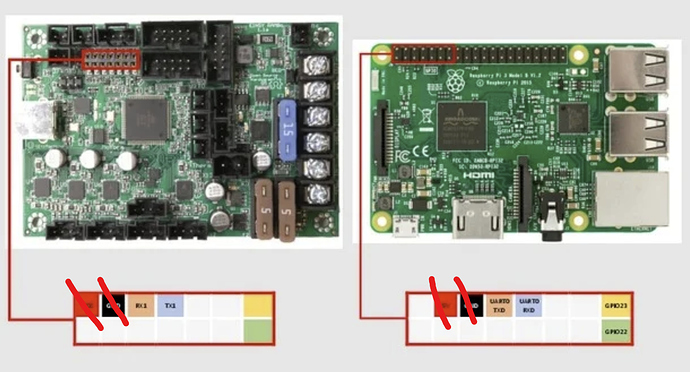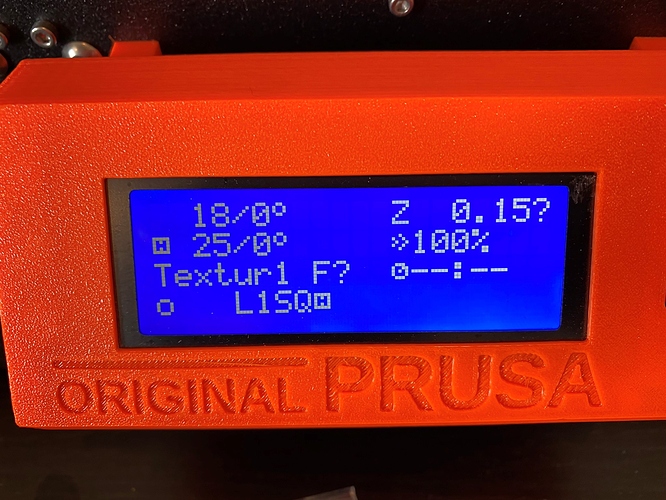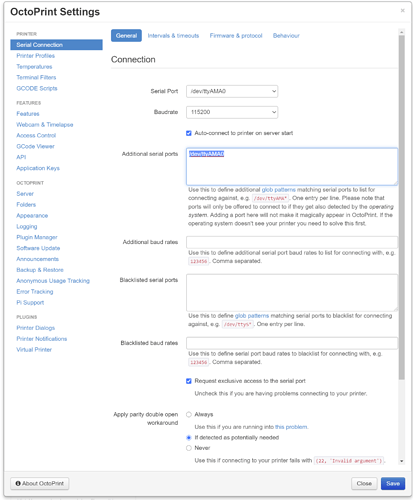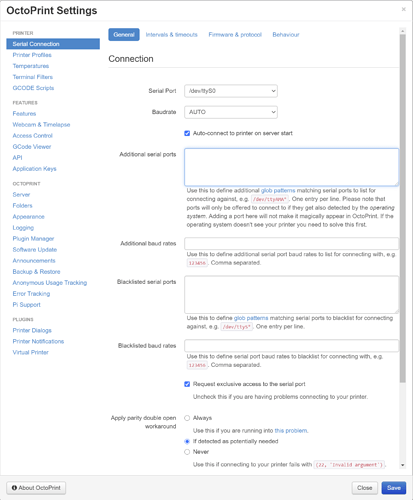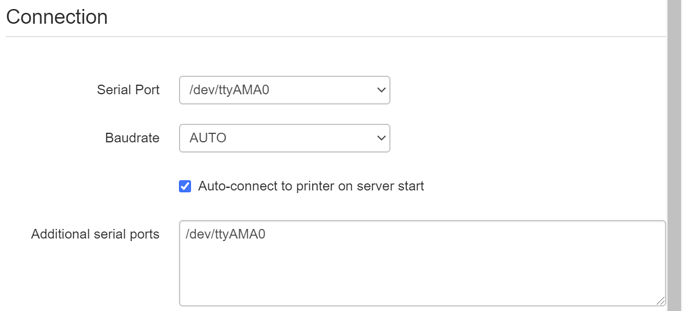you should putt the RPI to OFF on Prusa screen
Any update on this? Are you connecting via serial port on the Einsy Rambo board or via USB? I have a Pi4 and can connect via USB but not serial port. Any ideas how to connect Pi4 via serial port?
I am having this same issue. I am running power direct to the Pi4 8gb, then wiring up the four connections needed for the serial communication (I think).
No matter what I do I cannot get OctoPrint to connect. Yes, I have edited the /boot/config.txt and /boot/cmdline.txt
Here are my latest logs serial (1).log (3.9 KB)
Also it should be noted that I get funky text on the Prusa screen once the Pi attempts to connect. All I can think is that I actually need to wire up the 5v as well?? Seems redundant to the plugged in power supply.
Have you have connected the grounds together?
No, I didn't. I will test that.
Ok, I wired that up and now I get Error: Could not write to serial port. So, that's progress at least 
Here is the log for that one serial (3).log (2.1 KB)
I tried enablign and disabling the RPi port on the printer. That did not seem to make any difference. Is it required that I wire up the +5v? I had assumed that with external power I didn't have to do anything different.
I would have assumed the same thing here, but maybe the circuit has to be completed on the serial bus for it to register a connection for some reason. Don't know from experience but just spit balling ideas.
I can't fry it by giving it another 5v source can I? I'm guessing they designed these to be "smart" enough to handle that?
I wouldn't risk it.
hmmm...but I so badly want to fix it  . This thing is 500x faster than my Pi Zero!
. This thing is 500x faster than my Pi Zero!
I was just looking to see if there were any differences in the serial pins on 4 or not, I wouldn't think they would have changed that.
Yeah, I already checked the GPIO info and the pinout seems exactly the same. The only thing that is maybe slightly weird is that there is a fan plugged into pins 4 and 6.
I wonder if @TxBillbr might have an idea because I know he's pretty involved with Pi 4 and some of this stuff.
I really wish I would have known that the 8GB board was 64bit. I should have realized but you don't even think about it now that we've been on 64bit x86 for so long. I'm feeling like this thing is more headache than value right now.
OK, it has to be something with the Pi4 8GB. I wired it such that the 5v was coming from the einsy and not the external PSU and it still fails. The Pi is very responsive from the 5v provided by the einsy, but I still cannot connect to the serial connection.
I plugged my Pi Zero back in and it is working as slow as ever  . I have no idea what could be different as the Pi4 8GB doesn't list any changes to the GPIO.
. I have no idea what could be different as the Pi4 8GB doesn't list any changes to the GPIO.
There is one difference I had assumed was not relevant, but maybe it is. On my Pi Zero I get a serial port of /dev/ttyAMA0 whereas on the Pi4 8GB I get a port called /dev/ttyS0.
Pi Zero Serial Screen
Pi4 8GB Serial Screen
OK, it works if I manually enter in /dev/ttyAMA0.
There must be something off with this board of the logic in OctoPrint. At least I can start experimenting with this.
There have been a couple of firmware changes on my Prusa that seem to have affected the connecting of OctoPrint.
- I have had to explicitly put the device in the port to open field in OctoPrint.
- It seems that the connection (which causes a reset on the printer) needs to wait before trying to connect.
So autoconnect is not working at all for me. I chalked it up to the number of things I have going on with mine (I only have a 4GB model). I run OctoDash as well as the Tasmoda power control. I have heard that the 8GB pi has some quirky issues. Just so you know, enabling and disabling the USB on the Prusa controls whether the internal usb port is on or not. Prusa made a way to mount a Pi0W directly to the Einsy on the MK3S. I haven't ever tried to run both the external and internal at the same time. I don't know if they share any circuitry or not.
As to the power, I would not put any additional power into the MK3S! Not even with the grounds tied together. The power on the internal connector is provided by a VERY small buck that it capable of running a pi0. I reread all fo the issue discussed here and am concerned you may have clobbered something on the Einsy. I use a 5V-lift board to prevent driving the printer from the USB.
Edit. I am confused on the direct connect. The printer cannot drive the pi power. If I understand correctly you have external power on the pi. You are trying to direct connect the serial? I would prove to yourself that the "normal" way of connecting works fine before embarking on a direct-connect. Power the pi via a official pi power adapter and hook a good quality usb cable between them. Once that works, you will know if you have a board problem. If you do choose to direct connect the serial, you must have a GND connected. The minimal serial connection requires GND, TX, and RX. I am thinking that the other GPIO pins they connect may be RTS/CTS, but I don't know without doing some more research.
My path was similar. I started by powering the Pi with the official PSU and only connecting TX, RX, 22 and 23. That didn't work. So then I experimented with everything in between.
One of my experiments was to unhook the official PSU and power the Pi4 exactly like the Pi Zero using the 5v header. That worked, but still was not connecting to the serial connection.
What I now know as I have it working is:
- I must have the GND connected or else I get garbage on the Prusa screen
- I have to manually define the serial connection
/dev/ttyAMA0 - The fan that came with my Pi4 sounds like a screaming child unless I undervolt it
- The case I printed for the Pi4 sucks
That said, I'm looking good right now using the beta code and the Pi4 8GB.
That sounds like headway! I have been experimenting with different fan solutions and thus far have stuck to Noctua 5v connected to the usb port on the pi. I've ordered some temperature-based pwm fan controllers made with Chinesium so the jury is out there. If you use a level converter on a pwm port of the pi, you can mitigate the noise quite a bit. I've been using James Cameron's folding "case" for lots of mine. see (https://www.youtube.com/watch?v=ImdL78Qor8Y) where he is building pi cases 26 ways. 
I did the same thing in my case, but it's a little special. I have the Pi 4 mounted to one of those finned aluminum passive cooling armor cases and then my case has the noctua mounted just below the HyperPixel. I ended up splitting the 5V and ground off of one the header risers going to the HyperPixel with their quick connect.
